Walking the busy streets of Tamarindo, you’d never guess that just a short walk away is an estuary brimming with wildlife. From the river mouth at the northern end of town, a large wetland stretches inland. This rich ecosystem is home to tropical birds, crocodiles, monkeys, and other cool creatures. In this post, we’ll share what it’s like to take a Tamarindo estuary boat tour and what you might see.
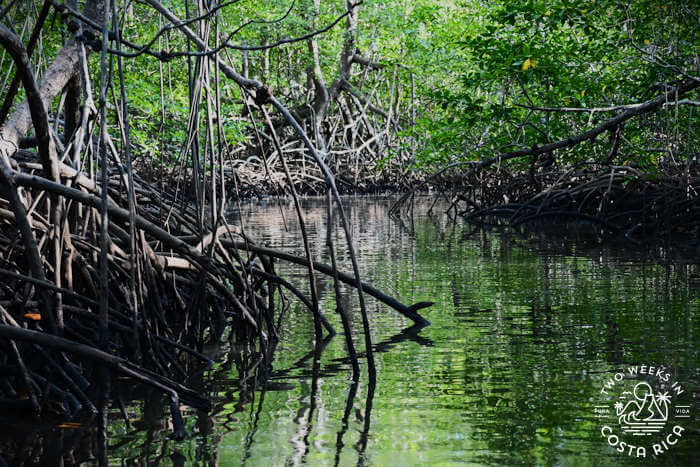
Background
The Tamarindo estuary is part of Las Baulas National Marine Park (Parque Nacional Marino Las Baulas). This important conservation area helps protect sea turtle nesting beaches, reefs, rivers, and mangroves in the highly developed areas of Tamarindo and Playa Grande.
The estuary attracts a lot of wildlife because it is an important source of water and food. This is especially true in the dry season when water is scarce.
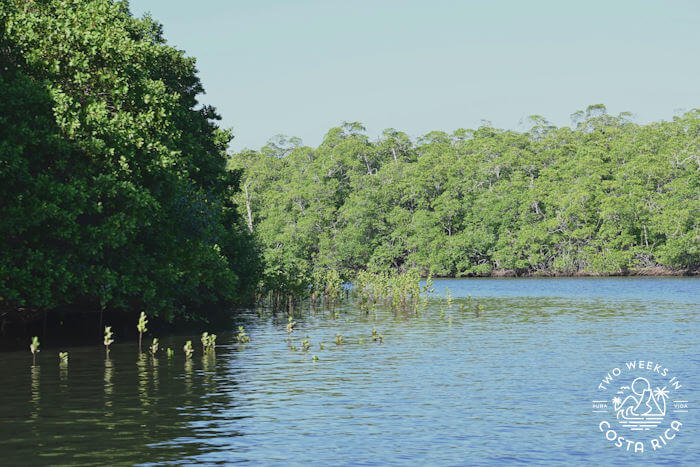
Tour Location
Boat tours of the Tamarindo estuary start near the river mouth. If you take the road out of town (toward Villareal), you will see some restaurants and shops on your left (e.g., Pangas Restaurant).
Just after these, there is a dirt pull-off, parking area, and small information building. This is where you will find the various guides/locals that offer the Tamarindo estuary tour.

We previously arranged a tour through one of the guides we found online. When we arrived, we just mentioned his name and another guide helped us find him.
Compared to other tours in Costa Rica, this one is very informal and a bit rustic. There are larger tour companies that offer it, but if you go through one of the local guides, you’ll likely be on a simple boat and the guide’s English may not be perfect. We still really enjoyed the tour, though.
Boarding the Boat
After traversing some steps down to the riverbank, we were greeted by our guide, William. He was just pulling up his small boat onto the sandy shoreline.
The skinny fiberglass boat had about ten seats and was covered with a canopy for shade.
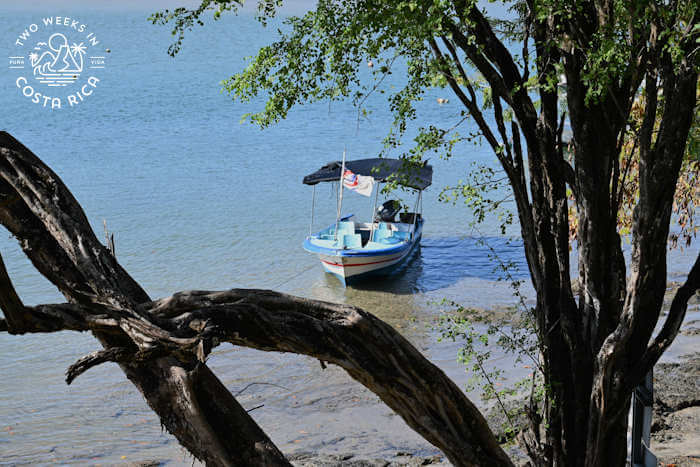
A handful of other visitors got on with us, then William’s helper pushed us off into deeper water. William fired up the small outboard motor and we were off.
The Wide River
From the launching point, the river was very wide and a bit choppy from the wind and ocean nearby. But William steered toward a calmer spot along the edge. As we continued upstream, the river narrowed, and he started pointing out some interesting things.
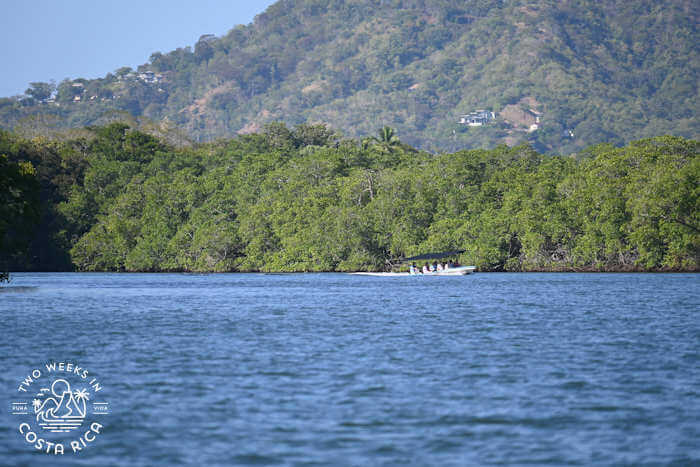
First, it was a large clump of brown wood on a nearby tree branch. William told us that this was a nest of arboreal termites. They live high in the tree for protection.
Next, we started to spot some birds. We saw several species of heron, including a Little Blue Heron, Green Heron, and Yellow-crowned Night Heron.
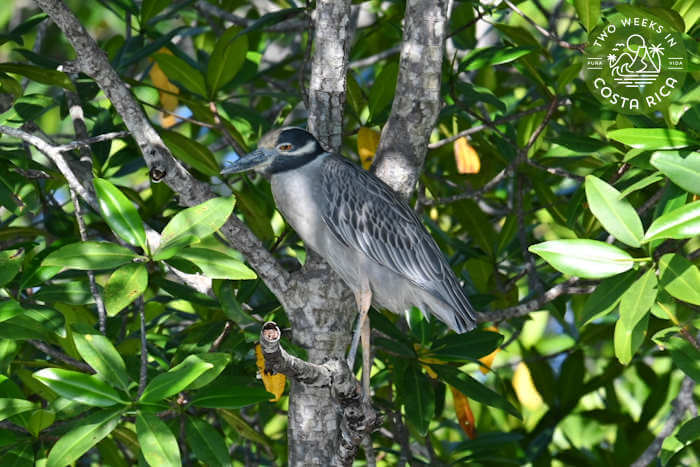
As we continued, the river became narrower. Thick mangrove roots and tree branches were all around us.
Deep Into the Mangroves
William carefully steered us through some narrower channels until we reached a fork.
To the right, we learned, was the Santa Rosa River, and to the left was the Matapalo River. He told us he was looking for a big crocodile he had seen earlier. When we arrived at the spot, the sandy bank was, unfortunately, empty.
Determined, our trusty guide motored onward. We could feel that the air was now much cooler because of the shady trees all around us.
William told us that there were five different species of mangrove in this area: black mangrove, red mangrove, white mangrove, piñuela mangrove, and button mangrove.
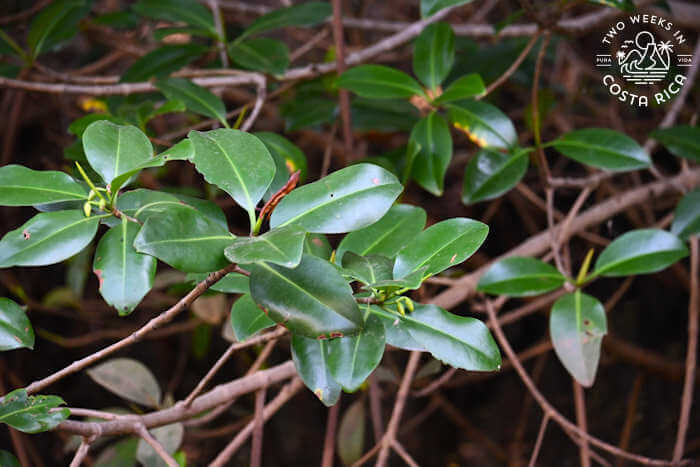
Along the impressive mangrove root structures, we could see lots of colorful crabs.
In the canopy overhead, there were many more birds too. Several Ringed Kingfishers swooped down near the top to the water, fishing. We then saw a Common Black Hawk, hunting from a high branch. There were also some big green parrots, squawking loudly as they flew around in the branches.

At one point, William turned off the motor and told us to listen. We could hear distant snapping sounds coming from all different directions.
William took out two shells and clanged them together, mimicking the sound exactly. These were a type of mangrove clam, he said. They snap their shells like that at low tide. William told us that locals use these clams in ceviche and soups.
Other Wildlife Sightings
Our tour through the mangrove continued for about two hours in total. In that time, we saw some other interesting wildlife.
One highlight was a mother racoon and her four or five tiny babies. William tried to get us closer, but the mother quickly scurried her little ones through the thick roots to somewhere safe.
On the way back, William pulled the boat onto shore and got out. He told us to wait. Apparently, there was usually a family of howler monkeys in this area, but not today.
We did spot an impressive Osprey high up in a tree, though. These birds of prey have a wide range all the way up to North America but are still a treat to see in Costa Rica.
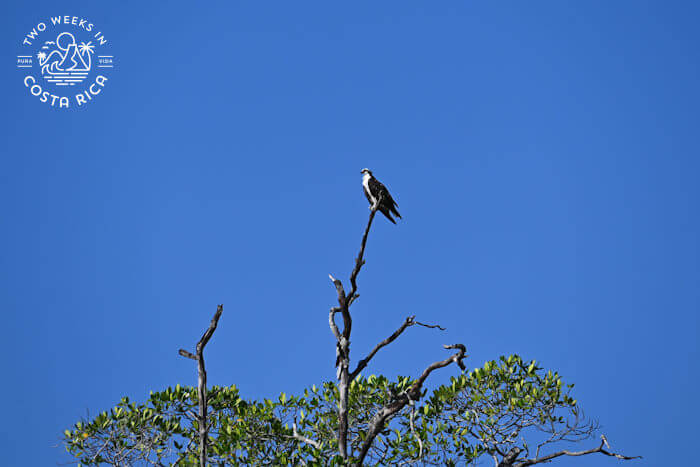
There was also a beautiful Snowy Egret, some White Ibis, and a Tri-colored Heron that posed for us. This tour would definitely be a good one for birders visiting Guanacaste!

Crocodile!
As William motored back toward the starting point, he suddenly turned the boat and pointed.
There on the riverbank was a small crocodile. Everyone was excited and we could tell William felt a bit relieved. A few of the people on the boat had really wanted to see a croc and he had struck out until now.
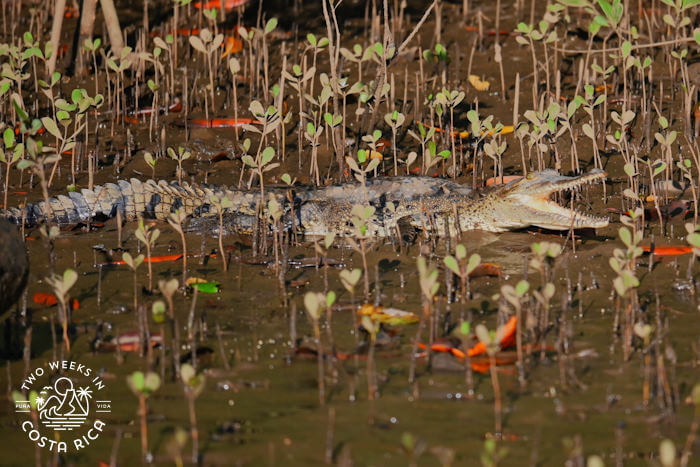
As we all took pictures from a safe distance, the young crocodile got a little nervous and decided to take a swim. Just to show us that he wasn’t retreating too easily, he showed his teeth in the water for another great photo opportunity.
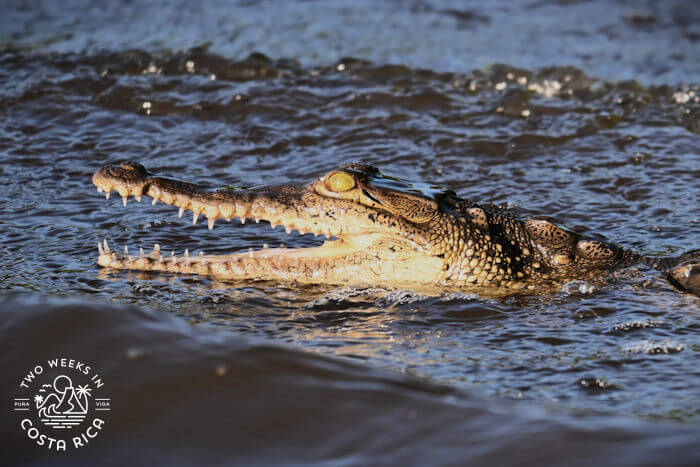
Booking a Tour
We booked our tour through Tamarindo Estuary Tours, using WhatsApp to contact the owner. If you are more comfortable booking online, some good options are available on TripAdvisor and Viator.
Tour Price
Around $45 USD per adult and discounts for children are typical, depending on the company you choose. Includes fruit and water.
Tour Times
Start times vary depending on the tide. The river and mangrove system are tidal and best visited during higher tides when there is more water.
Duration
2 hours
Accessibility
From the parking area, you have to go down a rustic stairway and then over some big rocks to reach the boats. The steps are steep and a little large but there is a railing to help.
There is no dock. You board the boat by wading into the shallow water (ankle to calf deep) and then have to take a big step up onto the boat. This could be challenging for people with limited mobility.

Conclusion
We have visited Tamarindo many times and had always wondered what it was like to take a boat tour of the Tamarindo estuary. We’re happy to report that it is an easy, short activity that will showcase some of Costa Rica’s impressive wildlife. It is especially great for people who would like to see birds and possibly crocodiles. Our entire family enjoyed it.
Have a question about the Tamarindo estuary tour or want to share what you saw? Leave us a comment below.
Some of the links in this post are connected to affiliate programs we have joined. If you make a purchase using one of the links, we get a small commission. This doesn’t cost you anything extra and helps us keep providing information on this website for free. Thanks for your support!
Looking for more information to help you plan your trip? Check out these posts:
River Float Wildlife Tour in Guanacaste – This tour is a full day of adventure and will bring you by rubber raft down a swift river, full of different wildlife. There’s also a visit to an impressive waterfall.
Palo Verde National Park: A Wildlife Tour Through Guanacaste’s Wetlands – Another longer day trip for birds and wildlife from Guanacaste, this one brings you to an enormous wetland called Palo Verde. This tour is more accessible and ideal for all ages.
Costa Rica Wildlife Guides: Our Picks – If you’re interested in learning more about Costa Rica’s critters, pick up one of these guidebooks before your trip.
